One of the most gorgeous and state-of-the-art museums in all of Europe, the Acropolis Museum is an absolute don’t-miss for any visit to Athens.
This newly-constructed museum has three floors of artifacts and archaeological wonders, with excellent descriptions, dioramas, and gobsmacking views of Athens’ sprawl.
What are the things you must see in the Acropolis Museum? Our shortlist guide has got you covered.

Acropolis Museum Highlights
Pottery from the slopes of the Acropolis
The first exhibit you will see in the museum is a vast collection of pottery both–geometric and black-figure styles– from the slopes of the Acropolis.
Make sure you check out the dozens of tiny Lekythoi, small vessels used for storing oil or perfume, with tiny intricate black figure depictions of god and goddess, chariot races, battle scenes, and the labors of Hercules.

The calf-bearer
During the 6th century BC, marble statues were dedicated by ancient artists or aristocrats and erected on the rock of the Acropolis, leaving the area looking like an open-air museum. One of the most impressive dedications is the Moschophoros or calf-bearer, a young man with a calf hoisted on his shoulders, ready to be sacrificed to the gods.
Sculpted in around 570 BCE with marble from nearby Hymettos, the stylized statue is an excellent example of the artistic norms and ideals of the time.
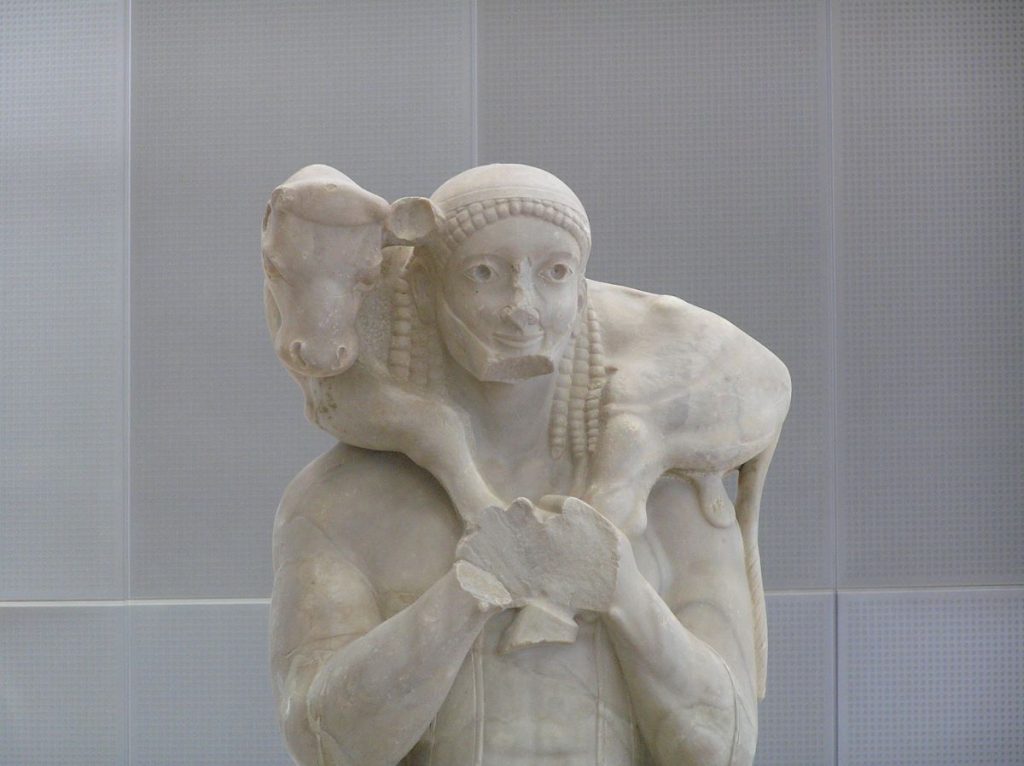
A colorized kore
The marble statues now in the Acropolis museum are the color of shiny alabaster, but when they were first dedicated they were painted in vibrant yellows, reds, greens, and blues.
These colors held for centuries as the dedications were buried after the Persian invasion of the Acropolis in 480 BC, and were protected from the elements, but faded quickly after they were excavated a few hundred years ago.
Luckily, thanks to the water-color paintings of some of these 19th-century archaeologists, we can understand the chromatic beauty these pieces once offered. Do check out the copy of Kore 685, painted to illustrate the way the ancients saw her, stood right next to the finely-sculpted marble original.

Traveler’s tip: Everyone’s top destination in Athens is, of course, the Acropolis. And, of course, like similar landmarks around the world, it is absolutely packed on most days. If you want to see the beautiful Acropolis in the most enjoyable way possible, check out our 9 Tips for Visiting the Acropolis.
The Caryatids
These towering figures are perhaps the top highlight of the Acropolis museum. These 5 female figures served as columns on the south portico of the Erechtheion, situated right next to the Parthenon.
The Caryatids stand tall and larger than lifesize, with column capitals crowning their intricate hairstyles, and the drapes of their dresses turning into the fluting of a column body.
Each one is completely unique, with differing features from her sisters. They are a wonder of ancient art and architectural prowess, and have been restored to impressive condition.

Nike adjusting her sandal
For an example of truly fine marble sculpture, check out the Nike adjusting her sandal from the Parthenon’s south parapet.
The draping of her dress and the fine tension visible in her muscles make it hard to believe she is truly crafted out of stone.
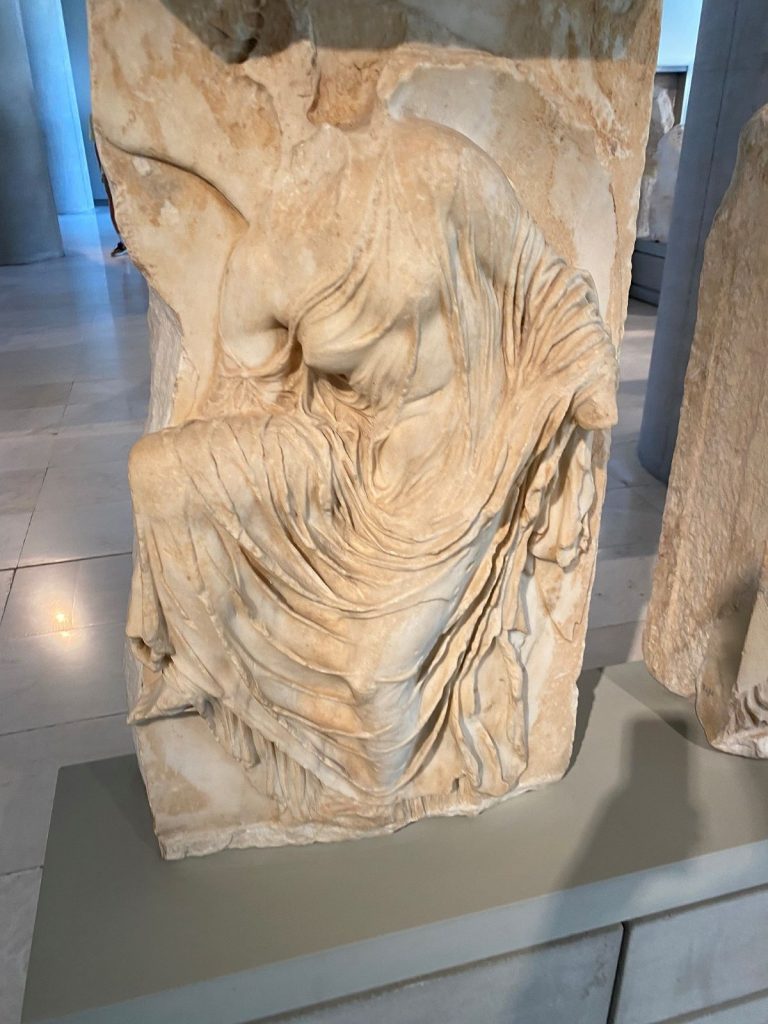
The sculptures of the frieze
The frieze was located on the interior of the Parthenon’s colonnade, high above the ground, and it encircled the entire inner chamber (the cella) of the temple. It is a continuous low-relief sculpture, spun out like a 3D comic strip, that depicts the Panathenaic procession, a massive parade held every four years in ancient Athens to honor the goddess Athena.
The figures are depicted in various poses and activities, interacting with each other, with animals, with a remarkable sense of movement and life. We love one piece from the North side that shows three men leading unruly bulls, tossing their horns in the air in protest, and a fragment from the West side that shows two riders in hoplite armor on galloping horses.
Many pieces of the frieze are missing from the Acropolis Museum, located in the British Museum, but there are plaster casts in their place so you can understand the full concept of the procession.
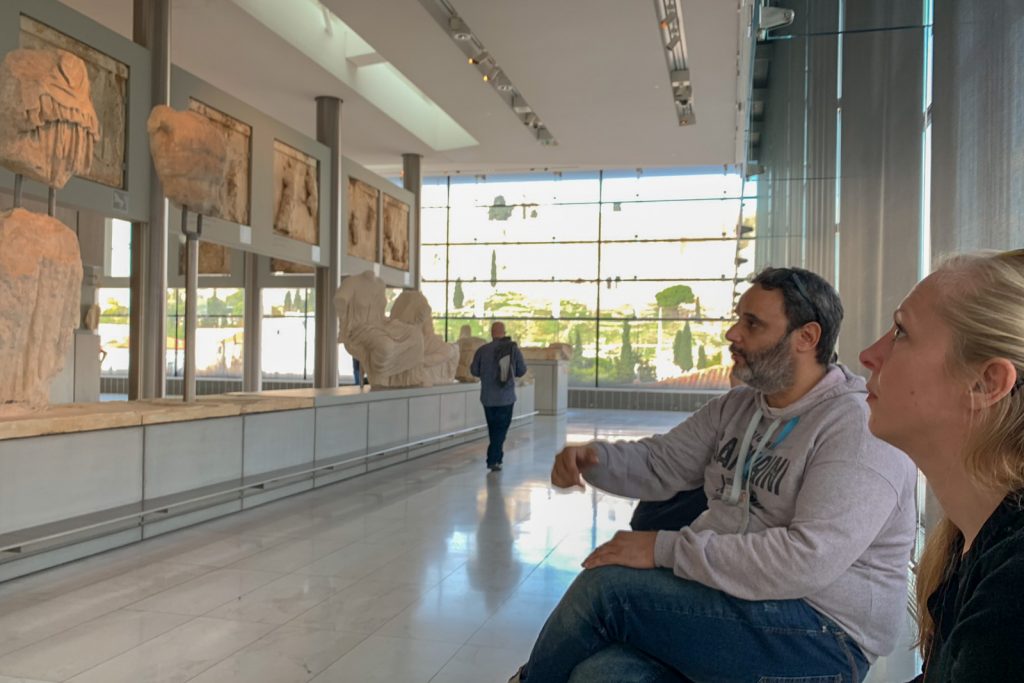
The pediment sculptures
The pediments on the Parthenon were the triangular gables on either end of the temple’s roof.
They were adorned with larger-than-life, elaborate sculptural groups that depicted the birth of the goddess Athena, and her competition for the city of Athens with the god Poseidon.
Many of the pediment sculptures are not in the museum, or have been significantly worn down by centuries watching over Athens, but the pieces that do remain show a truly masterful understanding of sculpture with marble clothes that drape like silk over tensed marble muscles.

Don’t miss these educational exhibits
A timeline of dioramas
When you first enter the museum, even before you validate your ticket, make sure to set out a set of dioramas that show what the Acropolis looked like at different periods in its many-faceted history.
This simple overview gives an easy reference for the many artifacts you will see, and helps you situate everything in time and space.

A LEGO Acropolis
For those traveling with kids, or just young at heart, the mostly-accurate semi-mythological LEGO Acropolis is a must-see. Made entirely out of LEGOS, this model has the theaters, ancient Greek figurines, hidden tunnels, and of course, the Parthenon.
This LEGO guide is right next to an educational children’s station, and is a perfect stop for littler visitors to engage with the museum.

A video showing the history of the Parthenon
If you want to understand the full history of the Parthenon do not miss this video on the top floor of the museum. Composed of archival photos and 3D renderings of the monument’s history, this short film gives a complete explanation of the many phases of the Acropolis.
It is truly fascinating to watch the digital construction and destruction of church spires, minarets, and war bunkers that have all spent time on the sacred rock.
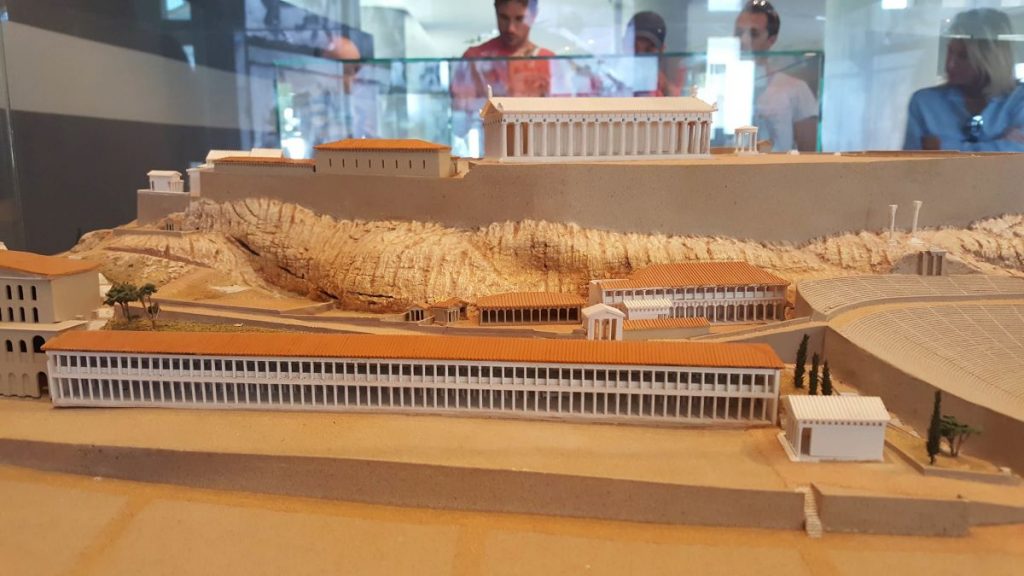
The Acropolis Museum: Practical info
Where is the Acropolis Museum and what are the opening hours?
The Acropolis Museum is located right in the middle of Athens’ central Plaka neighborhood, and right off the Acropolis metro station.
The museum opens every day of the week at 9am. In the winter the museum closes 5pm on weekdays, 10pm on Fridays, and 8pm on Saturday and Sunday.
In the summer the opening hours are extended, and it closes most days of the week at 8pm. The museum does close some holidays, so make sure you check the website for opening hours before you visit.

Is the museum accessible for those with disabilities?
Ramps for wheelchairs and strollers are available at all museum entrances, and there are elevators and accessible restrooms available on all floors.
Wheelchairs can be borrowed at the Information Desk, where a short guide to the museum written in Braille in both Greek and English is also available. Guide-dogs are allowed throughout the museum, and museum maps are provided.

Is the Acropolis Museum good to visit with children?
The museum has several accommodations for small children. Strollers for small children can be borrowed at the bag check by the entrance, and a parents’ room for the care of babies is available on the first floor.
Free family backpacks with activities are available at the Information Desk, and there is a kids corner with digital games located on the second floor next to the restaurant and the LEGO Acropolis.

How much does entrance cost?
Tickets prices vary depending on the season.
(There are a few days a year when entrance is free for all due to various holidays, so be sure to check out their website for details.)

Is there somewhere to eat in the Acropolis Museum?
There is a restaurant and a café on the second floor where you can enjoy snacks, beverages, or a full meal. The restaurant offers a range of Greek and international cuisine with a stunning view of the Acropolis.
It’s worth it to pass by for a photo even if you’re not hungry. The café, located on the ground floor, provides lighter fare and refreshments.
Insider tip: We recommend stopping in the restaurant halfway through your museum visit, to pause to soak in the surroundings and make sure you’re well fed before exploring the top floor with the frieze and pediment sculptures.

How long will a visit take?
To be sure you get the chance to at least see every exhibit in the museum, and check out all the highlights, we recommend planning at least a two-hour visit.
Of course if you want to stroll and make the most of your visit, it would be easy to pass many more hours in the museum.
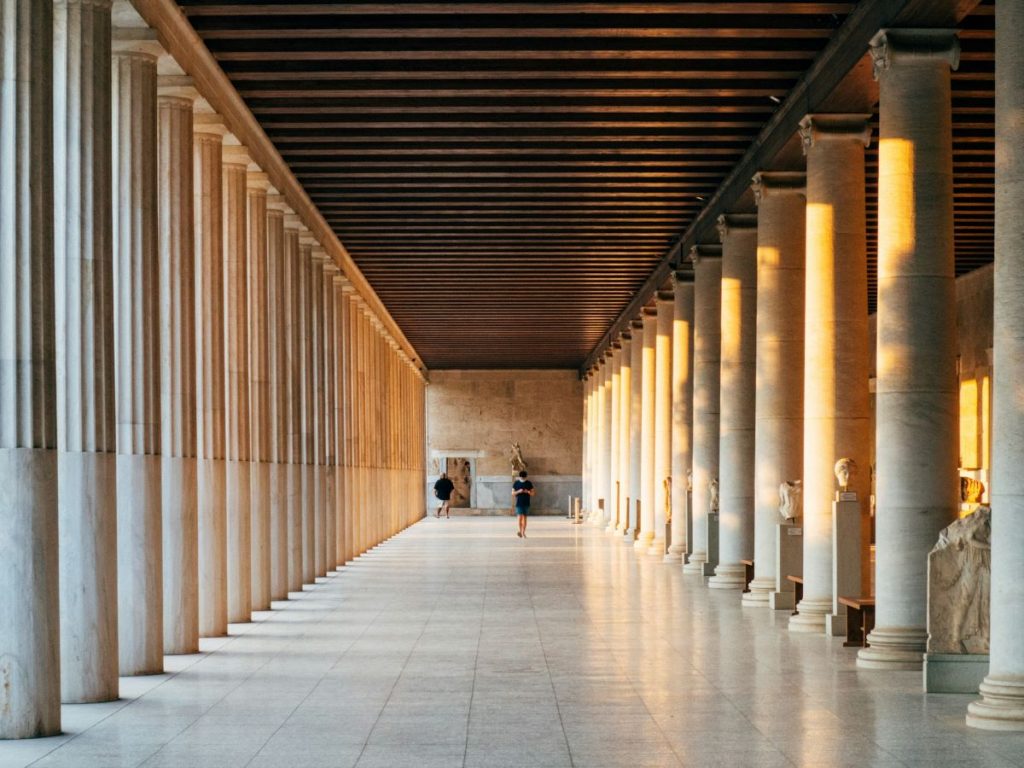
The Acropolis Museum is a must-visit for anyone coming to Athens. Whether to enjoy the views or the architecture, or to delve into the breadth and depth of material– there’s always something new to see and more to gain from this incredible resource. If you’d like to explore more of Athens’ art world, check out our list of the Best Art Museums in Athens.

